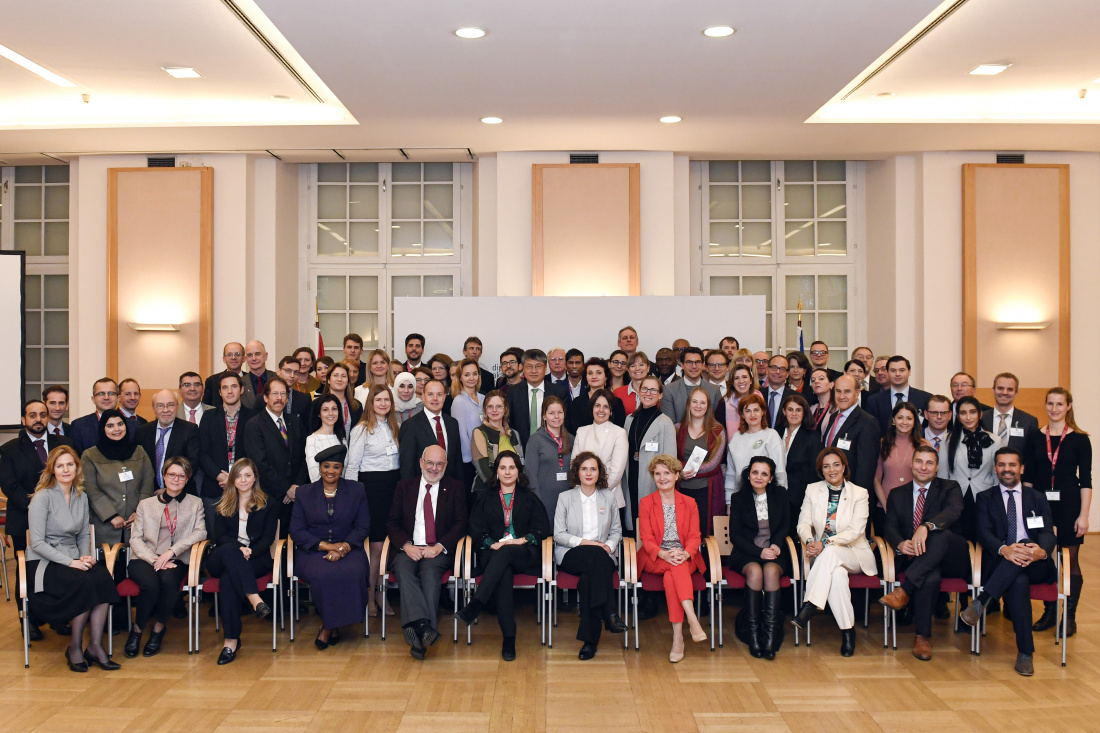From November 25-27, Vienna was a melting pot for science diplomacy practitioners from around the globe. Not only that the S4D4C consortium organised its second workshop on science diplomacy at the Diplomatic Academy (DA) of Vienna (completing the S4D4C science diplomacy workshop series comprising two events – a review about the first workshop in Trieste can be found here), also the meetings of the FMSTAN (Foreign Ministries Science and Technology Advisors Network) and SPIDER (Science Policy in Diplomacy and External Relations) networks took place during the same days in the Austrian capital.
Day 1
The S4D4C-own event was titled “Science Diplomacy Dynamics – Opening Science! Opening Diplomacy!” and featured a truly intensive programme with handpicked experts from the realms of science and diplomacy. 25 international participants were selected for the training workshop based on their qualifications, interests and experiences in science diplomacy (among them 16 female and 9 male). Susanne Keppler-Schlesinger, vice-director of the DA and partner in S4D4C, opened the event on Monday morning with some welcoming words and already stressed the “importance of science to answer to some of the world’s most pressing challenges like migration and climate change”. Sabine Ladstätter, who is the Director of the Austrian Archaeological Institute and the Excavation director at Ephesos (Austria’s largest scientific operation worldwide), used her keynote to cover both the historical development of Austria’s archaeological missions abroad until today and their political implications. She showed very vividly that almost all of these archaeological endeavours were framed either by some pre- or post-diplomatic negotiations. Allowing foreign experts to conduct excavations on one’s own land is a sensitive issue and the leaders of that time understood that. The most recent example she gave relates to her own work in Ephesos, where excavations were stopped in September 2016 due to political tensions between Austria and Turkey, and could be restarted only after the then foreign ministers Karin Kneissl and Mevlüt Cavusoglu decided to prioritise the subject on the bilateral diplomatic agenda and jointly agreed that the work should be continued. “It’s an example why archaeology shouldn’t be co-opted by politics, but politics can also be the problem-solver”, as Ladstätter concluded.
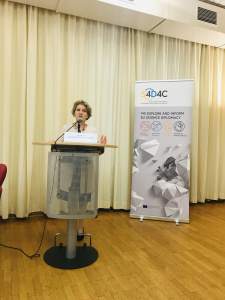
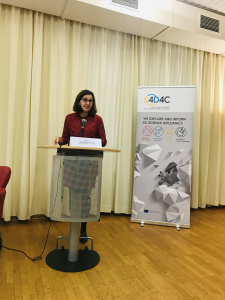
Elke Dall, S4D4C’s coordinator, moderated a panel discussion about new dynamics and trends in science diplomacy afterwards. Bernhard Fattinger (Health Attaché at Austria’s Permanent Mission to the United Nations in Geneva), Margit Bruck-Friedrich (Austrian Ambassador to the Slovak Republic), Johannes Caliskan (Attaché for Scientific and Academic Cooperation of the Institut Francais d’Autriche) and Maria Josten (Senior Scientific Officer at DLR and S4D4C partner) reflected upon their personal experiences being considered a “science diplomat”. And again it became obvious that the term science diplomacy has no terminatory definition and its interpretation is a matter of personal background. Mr. Fattinger stated that the term is “overblown” and science diplomacy practices have been existing long before a labelling was chosen – an observation which was affirmed also by Ms. Bruck-Friedrich, as she explicitly noted that “we (the Austrian foreign policy) always lived science diplomacy, otherwise we wouldn’t have been successful”. In her point of view, feeding scientific evidence into policy-making is just no matter of discussion any longer, but must rather be a fact. “We must also get rid of the ivory tower approach and think and act interdisciplinary, also in terms of cooperation between ministries”, she added. Mr. Caliskan gave examples of his work at the Institut Francais d’Autriche, which is a public institution under the French Ministry of Foreign Affairs and promotes the French culture, sciences and language abroad. In total, there are around 100 Instituts Francais around the globe. “They are working in the field of soft, cultural and science diplomacy”, as Mr. Caliskan explained. Maria Josten underlined that she definitely “feels like a science diplomat”. She cited past professional experiences, but also related to the new science, technology and innovation strategy of Germany she is dealing with in her job. “Science diplomacy is nowhere mentioned in this strategy, on the other hand it relates to all its activities”, Ms. Josten told the audience. In her eyes, science diplomacy is about “networking, managing and negotiating”.
„Diplomacy meets Science – New Dynamics, new Trends“ – Panel discussion already dives deep into the question what #ScienceDiplomacy is and how it configures in different (professional) contexts… pic.twitter.com/BmdCSm1F8r
— S4D4C Project (@S4D4C) November 25, 2019
Bertrand Fattinger at the @S4D4C and @DA_vienna questioning the label #sciencediplomacy when looking back at his own career. @zsi_fe pic.twitter.com/ZLLhWj88oD
— Katja Mayer (@katja_mat) November 25, 2019
The panel was also asked to provide concrete recommendations favouring the cooperation between science and policy. Some of them are subsumed below:
- Creation of more active networks between scientists and policy makers and provide platforms for exchange
- Establishment of a chief scientific advisory position at each prime minister’s office
- Underpinning of the UN 17 SDGs with a scientific Marshall Plan
- Europe’s future is in Africa!
- Promote cultural institutions as a place for scientific dialogue
In the afternoon of day one, the practical part started. Facilitated by three trainers (Maria Josten, Katja Mayer/ZSI and S4D4C partner and Michaela Told/Independent Consultant in global health), science diplomacy was approached from two specific angles, namely open science and global health. Rather than in a frontal presentation style, the three trainers actively approached the participants prompting them to think out loud, ask questions and, generally, inquire. This was done in view of the interactive role play on the following day.
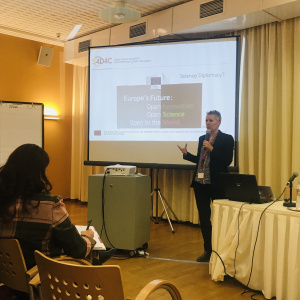
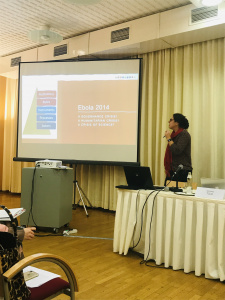
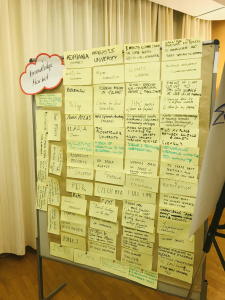
The day was rounded off when the S4D4C workshop participants joined the reception and panel discussion of the FMSTAN and SPIDER networks in Vienna’s Natural History Museum.
Thanks to the support of @ecology_ncl and @S4D4C I’m learning about the importance of #ScienceDiplomacy and the goals of it. Can’t wait for the night session at the Natural History Museum https://t.co/iUk2m6Ji5K
— Adriana Humanes (@adriana_humanes) November 25, 2019
Teresa Indjein, Director General for Cultural Policy at the Austrian Ministry of Foreign Affairs, and Albert van Jaarsveld, Director General of the International Institute for Applied Systems Analysis/IIASA (IIASA is an associated partner to S4D4C), delivered the keynotes on science diplomacy as a new element in Austrian foreign policy and on IIASA as a trust-builder institution between nations respectively. The Austrian MFA and IIASA were co-organisers of the FMSTAN/SPIDER meetings. Ms. Indjein took up the “urge for cooperation in view of today’s grand societal challenges” from Jeffrey Sachs, who called upon all stakeholders to act in his keynote at the FMSTAN/SPIDER meeting during the day at the premises of the Austrian MFA. And “science diplomacy is a relatively new field for Austria’s foreign policy”, which must “involve different ministries, universities and research institutions”. Ms. Indjein made clear that Austria’s foreign policy can rely on an excellent scientific environment and this channels into a number of Austrian embassies abroad which have already chosen specific science diplomacy priorities for their future work. Mr. van Jaarsveld listed five key challenges and possible pathways for the future in regard to science diplomacy as based on IIASA’s assessment (see picture below).
Teresa Indjein from @MFA_Austria opens the thematic part of today’s evening in the realm of #ScienceDiplomacy here in #NHM Vienna – with @S4D4C @INGSciAdvice @IIASAVienna @DA_vienna pic.twitter.com/K55INHw8ca
— S4D4C Project (@S4D4C) November 25, 2019
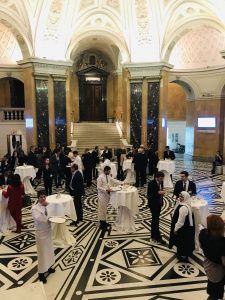
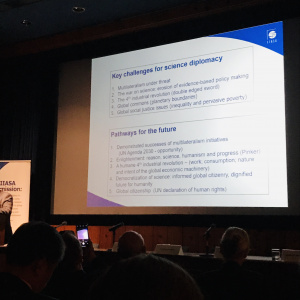
In a panel discussion (moderated by Leena Srivastava, Deputy Director General at IIASA) on challenges for science diplomacy in the current geopolitical environment, Sir Peter Gluckman, Chair of the International Network for Government Science Advice and President-elect of the International Science Council, Barbara Weitgruber, Director General for Scientific Research and International Relations at the Austrian Ministry for Education, Science and Research, Lassina Zerbo, Executive Secretary of the Comprehensive Nuclear-Test-Ban Treaty Organisation, Vaughan Turekian, SPIDER co-chair and Executive Director at the US National Academies of Sciences and Aminata Sall Diallo, Special Adviser to the Minister of Higher Education and Research of Senegal, raised a series of interesting observations. One of the common parentheses drawing on the statements of participants was that “more science is needed than ever to make policies really work”. Against the looming failure of the UN SDGs, which do not have enough scientific basis, and society’s need to adapt adequately and timely to the disruptive technological changes the world sees today (Gluckman), new ways of thinking and integrating science and technology based evidence in policy proposals are desperately needed. Transnational cooperation in research and innovation, which – per se – could provide this evidence and which is promoted actively by Horizon 2020 and the forthcoming Horizon Europe is not purely “good” or “positive”, but also bears aspects of competition and favouritism (“Europe first” and strategic association considerations with specific countries) (Weitgruber). The silos of science and diplomacy need to be broken and here only science diplomacy can help (Zerbo). We moved from a “cold war to a gold war” because science and technology (S&T) more and more relate to economic competitiveness. Can every (developing) country live up to the role as a strong S&T performer in that case? It needs a new group of interlocutors to translate between science and policy, but also between science and economy (Turekian). How do we fund large science missions currently and how should it be done? Given that the achievement of the SDGs should become a reality, we ought to consider that science is needed to get there and that this is a question of providing sufficient funding. A global science diplomacy agenda does not evolve on its own (Sall Diallo). In the discussion, it was stated that hope and inspiration are key ingredients and we should not hesitate to think out of the box and involve those that are concerned actively in the research processes and also to bring science closer to decision making.
Day 2
After Peter McGrath’s (TWAS, S4D4C partner) presentation on the International Science System seen as in the shoes of a principal investigator, which kicked off the second day, the workshop participants and the FMSTAN/SPIDER colleagues gathered in the “Festsaal” of the Diplomatic Academy for listening to a panel discussion devoted to a very topical question when looking at science diplomacy: “What role for science in diplomatic curricula and, vice versa, what role for diplomacy in scientific curricula?”. The panel was moderated by Paul Yillia (IIASA) and included Emil Brix (Director, DA), Brigitte Gerstmann (MA student in environmental technology & international affairs/ETIA at DA), Jan Marco Müller (IIASA), Clemens Mantl (former director of the Office of Science and Technology Austria in Washington, DC) and Susanne Keppler-Schlesinger (Deputy Director DA, S4D4C partner).
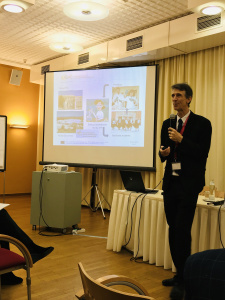
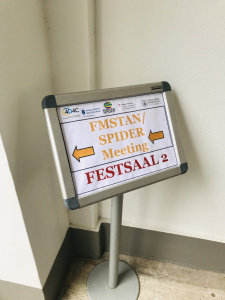
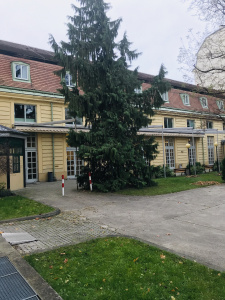
“It’s a continuous effort and has become essential to integrate science elements into diplomatic curricula for the Diplomatic Academy of Vienna”, said Emil Brix. “The Master programme in environmental technology & international affairs is a unique programme as it took up this approach and is based on a strong scientific background”, added Ms. Gerstmann. Also Jan Marco Müller concurred when noting that “IIASA is proud that several of its scientists are regularly involved in political committees or negotiations in order to provide scientific advice to the policy makers”. Mr. Mantl raised the question what (funding, mechanisms etc.) and whose (which stakeholders should be consulted) contribution is “really needed to create such types of curricula”. Ms. Keppler-Schlesinger alluded to the S4D4C project when mentioning that “it offers these tailor-made trainings already and that online training modules for science diplomats are to be released soon as well”. “The next round of Austrian young diplomats will be definitely trained in science diplomacy”, she added.
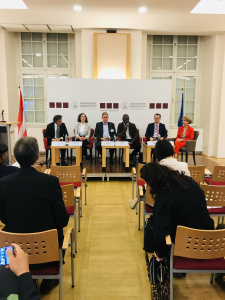
In the afternoon the practical part of the S4D4C workshop continued and the interactive role play on open science challenges in global health was started. The following situation was practiced: The WHO adopted its 13th General Programme of Work (GPW) as a key strategic document for the years 2019-2023. It includes an ambitious goal, namely to reach a “triple billion” for better health: 1 billion more people enjoying better health and well-being, 1 billion more people benefitting from universal health coverage, and 1 billion more people better protected from health emergencies. In an informal intergovernmental consultation organised by the WHO targets and indicators for health emergencies in the GPW should be developed. Each of the 25 workshop participants was assigned a personal role for the meeting, comprising a national health ministry representative, a director of a national public health institute, the head of the open research department of Wellcome Trust (research charity), the general manager of CKERM pharma (a fictive pharma company), a representative of CODATA (Committee on Data for Science and Technology) and the Chief Scientist of WHO.
Thank you for engaging in a debate at the nexus #OpenScience #diplomacy and #globalhealth. Political and scientific preparations are equally important for negotiations ! A good lesson from the workshop. @katja_mat @S4D4C https://t.co/Nbt6XF15Ne
— Michaela Told (@MichaelaTold) November 26, 2019
The task was to take over the assigned role and to participate in the proposed meeting by promoting one’s own institutional interest – all against the backdrop of reaching common targets and indicators for health emergencies as part of the 13th GPW as stated previously. Each group of stakeholders was allowed to have internal consultations before choosing one representative (pars pro toto) for the public plenum during which the various positions were exchanged and negotiated. All in all, the working spirit was very dynamic and positive and people truly enjoyed simulating the specific characters.
Day 3
Definitely a highlight of the 3-days programme was a study visit to the United Nations Office in Vienna. More concretely, the S4D4C group was invited to learn about the United Nations Office for Outer Space Affairs (UNOOSA) and the International Atomic Energy Agency (IAEA). UNOOSA is an individual unit integrated into the UN system and works to promote international cooperation in the peaceful use and exploration of space, and in the utilisation of space science and technology for sustainable economic and social development. IAEA is the world’s centre for scientific and technical cooperation in the peaceful use of nuclear technology and was set up as the world’s “Atoms for Peace” organisation within the United Nations family in 1957.
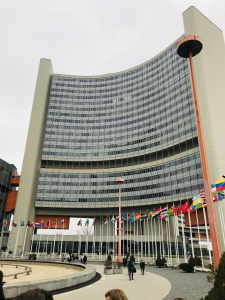
It started off with an introduction about why mankind started to explore outer space by visiting the permanent exhibition of UNOOSA. Jorge Del Rio Vera (Programme Officer at UNOOSA) eloquently brought the group closer to all the technical background of a mission to space and took the young scientists and diplomats on a journey through time when he gave details about the most famous missions launched and the countries involved. “In times of political tensions, countries still used to cooperate in outer space, such as in the case of the USA and the former Soviet Union”, Mr. Del Rio Vera pointed out. Markus Woltran (Programme Officer, UNOOSA) in his presentation wrapped up the manifold activities of UNOOSA and its mandate. For instance, he mentioned the “Space 2030 agenda“, as “long-term vision how space is contributing to the 2030 Sustainable Development Agenda”. Jean-Pierre Cayol (Programme Coordinator at IAEA) addressed the group with some intriguing insights into the daily work of the IAEA on the basis of two examples: Nuclear technologies for applications on food production and on preventing insect and animal-borne diseases. It was astonishing to learn how much can be done with the peaceful use of nuclear technology. Commonly the IAEA is understood as the international body to control and monitor the non-proliferation of nuclear weapons and to guarantee that the use of nuclear material and facilities is only for peaceful purposes, as it reads also in IAEA’s mission statement. Niklas Hedman (Chief of the Committee, Policy and Legal Affairs Section at UNOOSA) finished this morning session with pointing to some of the legal aspects which come into play when negotiating the UNOOSA’s member states interests in the outer space.
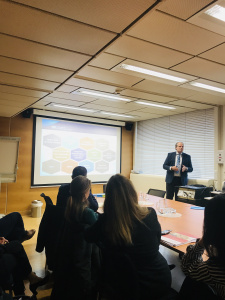
Having returned to the Diplomatic Academy, the day closed with a debriefing by Susanne Keppler-Schlesinger and the award of certificates for all participants. What was left are 25 visions of science diplomacy in the future, one per each participant. 25 visions full of optimism, engagement and bold ideas!
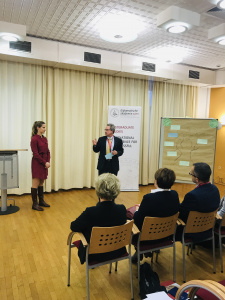
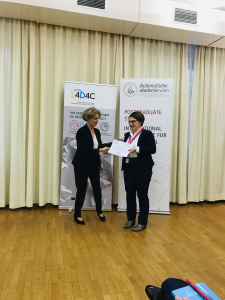
(credits group photo: Mahmoud/BMEIA)

